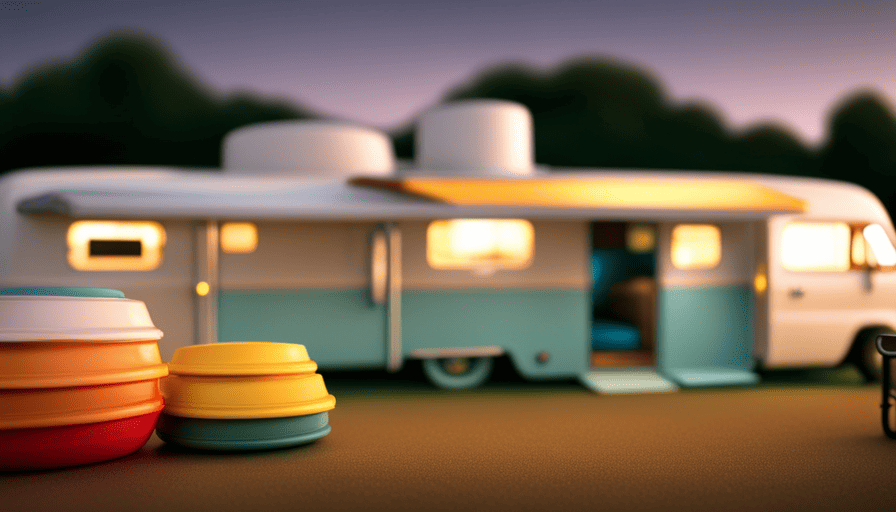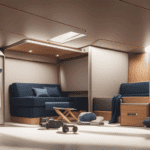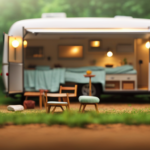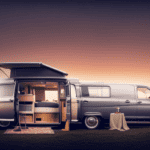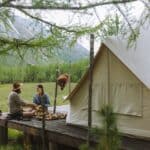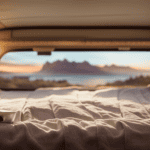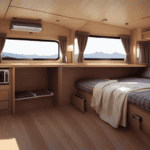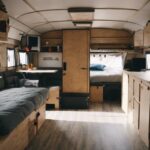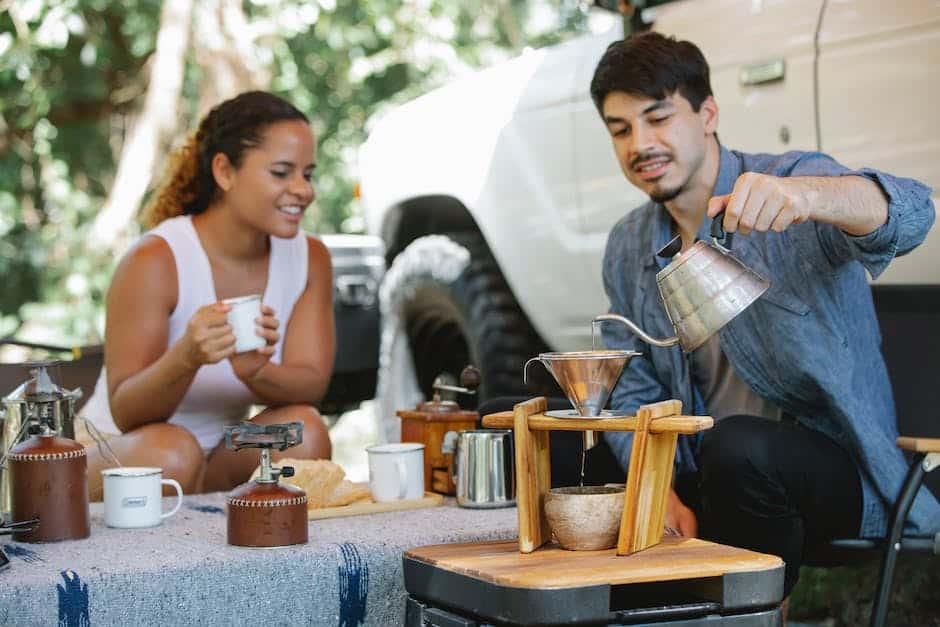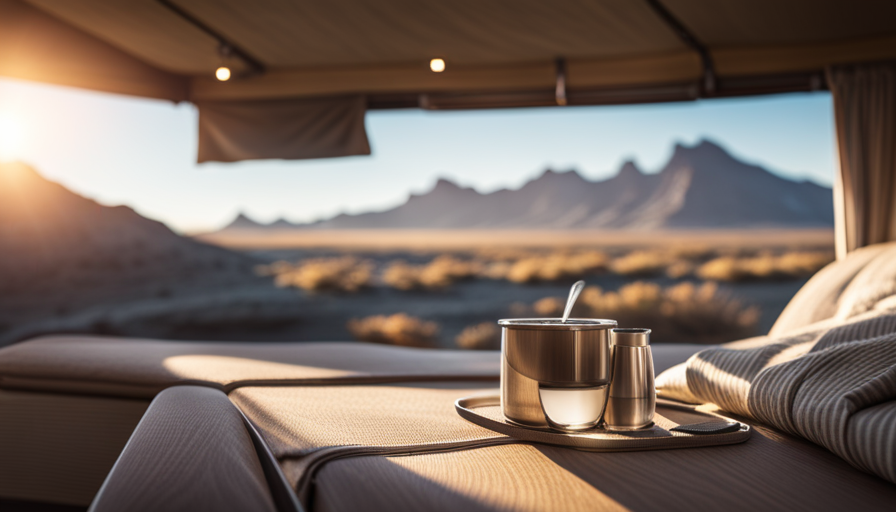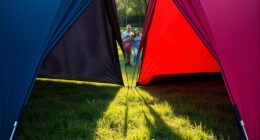Are you tired of the same old camping routine? Ready to take your outdoor adventures to the next level? Get ready to embark on an amazing DIY project that will amaze you!
Converting a cargo trailer into a camper is not for the faint of heart, but trust me when I say, the end result is absolutely mind-blowing!
Picture this: a cozy, personalized space that’s tailored to your every need and desire. From a comfortable sleeping area to a fully functional kitchenette, the possibilities are endless. With a little bit of creativity, a dash of determination, and a whole lot of elbow grease, you can transform a simple cargo trailer into your very own home on wheels.
In this article, I will guide you through the step-by-step process of converting a cargo trailer into a camper. We’ll cover everything from assessing your needs and budget to adding those personal touches that make it uniquely yours.
So, grab your tools and let’s get started on this incredible journey!
Key Takeaways
- Assess needs and budget before starting the conversion
- Design functional and comfortable sleeping arrangements
- Create a functional kitchenette with space-saving storage solutions
- Plan and install plumbing and electrical systems for a functional camper
Assess Your Needs and Budget
Before you start converting your cargo trailer into a camper, assess your specific needs and budget to ensure you create a personalized and cost-effective living space that meets all your travel requirements.
Start by assessing your requirements – how many people will be using the camper, what amenities do you need, and what type of travel will you be doing? This will help you determine the size and layout of the camper, as well as the necessary features such as a bed, kitchenette, bathroom, and storage space.
Financial planning is also crucial during this stage. Determine how much you’re willing to spend on the conversion and set a budget accordingly. Consider the costs of materials, tools, and any professional help you may need. It’s important to strike a balance between quality and affordability to ensure you get the most out of your investment.
Once you have assessed your needs and budget, you can begin planning the layout and design of your camper. This involves deciding where each component will be placed, considering factors such as weight distribution and functionality.
By carefully assessing your requirements and financial situation, you can create a well-designed and cost-effective camper that perfectly suits your travel needs.
Plan the Layout and Design
When planning the layout and design of your cargo trailer camper, it’s important to consider your sleeping arrangements. Whether you prefer a fixed bed or a convertible seating area, it’s crucial to prioritize comfort and functionality.
Additionally, creating a functional kitchenette will be essential for meal preparation on the road, so be sure to include appliances and storage solutions that fit your needs.
Lastly, designing a comfortable living area will help make your camper feel like a home away from home, so consider factors such as seating options, entertainment systems, and storage for personal belongings.
Consider Your Sleeping Arrangements
As you plan your cargo trailer conversion, envision your sleeping arrangements as the cozy nest where you’ll retreat after a long day of adventuring, like a hammock gently swaying between two palm trees on a tropical beach.
When it comes to bed options, there are several possibilities to consider. One popular choice is a convertible sofa bed, which offers a comfortable seating area during the day and easily transforms into a cozy sleeping space at night.
Another option is a bunk bed setup, which maximizes the use of vertical space and is ideal for families or those traveling with friends. Whichever option you choose, make sure to prioritize comfort and functionality.
Now, let’s transition into the subsequent section about creating a functional kitchenette.
Create a Functional Kitchenette
Designing a functional kitchenette in your cargo trailer conversion is the key to cooking up delicious meals on the road. To make the most of your space, here are some functional kitchenette ideas and space-saving storage solutions:
- Install a compact yet efficient stove and oven combo to save space.
- Opt for a foldable or extendable countertop that can be easily stored when not in use.
- Utilize vertical space by adding shelves or hanging racks for pots, pans, and utensils.
With these clever storage solutions, you can maximize your kitchenette’s functionality while still having room for all your cooking essentials.
Now that you have a well-designed kitchenette, it’s time to move on to creating a comfortable living area where you can relax and unwind after a long day on the road.
Design a Comfortable Living Area
Now that you’ve created a functional kitchenette, it’s time to kick back and design a cozy living area where you can unwind and relax during your road trips. Comfortable seating is essential for a cozy living area, so consider investing in a comfortable sofa or armchairs that can also double as sleeping quarters.
To maximize space, opt for furniture that can serve multiple purposes, such as a coffee table that can also be used as storage or a bench with built-in compartments. Additionally, think about incorporating foldable furniture that can be easily stored away when not in use.
When choosing the right materials and tools for this section, keep in mind durability and ease of cleaning. This will ensure that your living area remains comfortable and inviting throughout your travels.
Transitioning into the subsequent section, let’s explore how to choose the right materials and tools to bring your vision to life.
Choose the Right Materials and Tools
First, gather all the essential materials and tools needed to transform your cargo trailer into a cozy camper. When choosing the right materials for conversion, it’s important to consider durability, weight, and functionality. Opt for lightweight yet sturdy materials that can withstand the rigors of travel.
Some popular options include plywood for the walls and ceiling, vinyl flooring for easy maintenance, and insulation for temperature control. Additionally, consider using water-resistant materials for areas prone to moisture, such as the bathroom or kitchen.
As for the essential tools needed for the conversion, make sure to have a good set of power tools, including a drill, saw, and sander. These will come in handy for cutting and shaping materials. Don’t forget about measuring tools like a tape measure and level to ensure accurate installations. Other useful tools include a staple gun for securing materials, a paintbrush for applying finishes, and a caulking gun for sealing gaps and joints.
With the right materials and tools at your disposal, you’ll be well-prepared to tackle the next step of the conversion process: insulating and weatherproofing the trailer. By properly insulating your camper, you can create a comfortable living environment regardless of the outside temperature.
Insulate and Weatherproof the Trailer
After gathering the necessary materials and tools, it’s time to roll up my sleeves and ensure that my trailer is properly insulated and weatherproofed, creating a cozy haven for my future adventures.
Insulation techniques play a crucial role in maintaining a comfortable temperature inside the trailer, regardless of the weather conditions outside. One popular method is to use foam board insulation, which is lightweight, easy to cut, and provides excellent thermal resistance. Another option is to use spray foam insulation, which expands to fill gaps and provides a seamless barrier against drafts and moisture.
In addition to insulation, weatherproofing methods are essential to protect the interior from rain, wind, and other elements. One effective way to weatherproof the trailer is by applying a waterproof sealant to all seams and joints. This prevents water from seeping in and causing damage. Another important step is to install weatherstripping around doors and windows to create a tight seal. This not only keeps the weather out but also helps with sound insulation. Lastly, I’ll consider adding skirting to the bottom of the trailer to further protect it from the elements.
With the insulation and weatherproofing completed, it’s time to move on to the next step: installing windows, vents, and lighting.
Install Windows, Vents, and Lighting
To create a bright and well-ventilated haven for your future adventures, it’s time to illuminate your space, let fresh air in, and install windows, vents, and lighting.
Installing windows is essential to bring natural light into your camper and create a sense of openness. Look for windows specifically designed for trailers, ensuring they’re properly sealed to prevent leaks. You can also consider installing skylights, which not only add more natural light but also provide a beautiful view of the sky above.
In addition to windows, vents are crucial for airflow and ventilation. Roof vents are commonly used in campers to expel hot air and keep the interior cool. They come in various styles, including manual and powered vents. To maximize energy efficiency, you might consider incorporating solar power to operate the vents and lighting. This way, you can harness the sun’s energy to keep your camper well-lit and ventilated, even when off-grid.
Now that your camper is well-lit and properly ventilated, it’s time to move on to the next step: building custom furniture and storage. By doing so, you can optimize your space and create a comfortable living area that suits your needs.
Build Custom Furniture and Storage
After installing windows, vents, and lighting in your cargo trailer-turned-camper, it’s time to move on to the next exciting step: building custom furniture and storage. This is where you can truly make your camper feel like a home away from home, with personalized touches and space optimization.
One of the key aspects of converting a cargo trailer into a camper is making the most of the limited space available. By designing and building custom furniture, you can ensure that every inch of your camper is utilized efficiently. From beds and dining areas to kitchenettes and storage cabinets, the possibilities are endless.
To help you visualize the possibilities, I’ve created a table below that showcases how you can maximize space in your camper:
| Furniture/Storage | Function | Features |
|---|---|---|
| Built-in Bed | Sleeping | Foldable design for daytime use |
| Dining Table | Eating | Collapsible for extra space |
| Kitchenette | Cooking | Compact appliances and ample storage |
| Storage Cabinets | Organizing | Customized compartments for efficient storage |
By customizing your camper’s decor and furniture, you can create a space that reflects your personal style and meets your specific needs. Whether you prefer a rustic or modern aesthetic, there are countless options for materials, finishes, and layouts to choose from.
In the next section, we will explore how to install plumbing and electrical systems, which are essential for a functional camper.
Install Plumbing and Electrical Systems
Don’t you love the thought of dealing with the joys of installing plumbing and electrical systems in your cozy little home on wheels? Well, let me tell you, it’s a task that requires some knowledge and experience, but it’s definitely worth it.
When it comes to electrical systems, you’ll need to plan the layout carefully, considering the power requirements of your appliances and devices. Don’t forget to install a reliable source of power, such as solar panels, to keep your camper off-grid and self-sufficient.
As for plumbing, you’ll want to choose the right fixtures that are compact and efficient. Look for space-saving options like compact toilets and versatile sinks. Installing a water heater and a water pump will ensure you have hot water and good water pressure for all your needs. Don’t forget to include a greywater tank to collect and dispose of wastewater properly.
Once you have your plumbing and electrical systems in place, you can move on to the fun part – adding personal touches and decorations to make your camper feel like home. So let’s get creative and transform this cargo trailer into a cozy haven on wheels.
Add Personal Touches and Decorations
Transforming your cozy little home on wheels is all about adding personal touches and decorations that will make it feel like your own oasis on the road. Now that you’ve installed the plumbing and electrical systems, it’s time to put your creative skills to work and personalize your camper’s interior.
Start by selecting a theme or color palette that reflects your personality and preferences. This will set the tone for the entire space. Consider using removable wallpaper or paint to add a pop of color to the walls, and invest in comfortable bedding and curtains that match your chosen theme.
To truly make your camper feel like home, don’t forget to add personal mementos and decorations. Hang up your favorite photos, artwork, or souvenirs from your travels. Display items that hold sentimental value, such as trinkets collected along the way or a map with pins marking the places you’ve visited. Incorporate storage solutions that are both functional and aesthetically pleasing, like baskets or shelves adorned with decorative items.
Once you’ve personalized and decorated your camper’s interior, you’re almost ready to hit the road. But before you do, it’s important to test everything and make any necessary adjustments. This will ensure that your cozy oasis is not only beautiful but also functional and safe for your adventures ahead.
Test and Make Necessary Adjustments
Once you’ve added your personal touches and decorations, it’s time to put your cozy oasis to the test and make any necessary adjustments for a smooth and safe journey. Testing your newly converted cargo trailer camper is an essential step before hitting the road.
There are several testing methods you can employ to ensure everything is in working order. First, check all the electrical systems. Make sure all the lights, outlets, and appliances are functioning properly. Test the water system by filling up the tanks and checking for any leaks or malfunctions. Run all the faucets and showers to ensure a steady flow of water.
Next, test the sleeping and seating areas. Lie down on the bed and sit on the couch or chairs to ensure they’re comfortable and stable. Check the storage compartments and make sure they’re secure and accessible.
During the testing process, keep a list of any issues or adjustments that need to be made. This’ll help you troubleshoot and address any problems before you embark on your journey.
Once you’ve completed the necessary adjustments, you’ll be ready to hit the road and enjoy your new camper!
Hit the Road and Enjoy Your New Camper!
Now that all the necessary adjustments have been made, it’s time to hit the road and fully enjoy your cozy oasis on wheels!
As an experienced camper, I can provide you with some RV travel tips to ensure that your journey is smooth and enjoyable.
First and foremost, make sure to plan your route and check for any road closures or construction. It’s also a good idea to have a GPS or navigation system to guide you along the way.
As you embark on your adventure, make sure to pack essential camping gear such as a tent, sleeping bags, cooking utensils, and a portable stove. Don’t forget to bring enough food and water to last you throughout your trip.
When it comes to RV travel, safety should always be a top priority. Make sure to check your tires, brakes, and lights before hitting the road. It’s also important to secure all loose items inside your camper to prevent accidents while driving.
Lastly, don’t forget to have fun! Take advantage of the freedom that comes with having your own camper and explore new places. Whether it’s a national park, a beach, or a cozy campground, there are endless possibilities for adventure.
So, now that you’re all set, hit the road and enjoy the freedom and comfort of your new camper. Happy travels!
Frequently Asked Questions
What are some tips for finding affordable materials and tools for converting a cargo trailer into a camper?
Finding affordable materials and tools for converting a cargo trailer into a camper can be a real treasure hunt. It’s like unearthing hidden gems in a DIY paradise.
One of my favorite hacks is scouring online marketplaces and local classifieds for used camping gear or RV parts that can be repurposed.
Thrift stores, salvage yards, and even yard sales can also be gold mines for finding cheap materials to transform your trailer into a cozy home on wheels.
How can I ensure that my camper is properly insulated and weatherproofed?
To ensure proper insulation and weatherproofing in my camper, I would use effective insulation methods such as spray foam insulation or rigid foam boards. These provide excellent thermal resistance and prevent air leaks.
Additionally, I would use weatherproofing techniques like sealing all windows, doors, and any other potential entry points with silicone caulk or weatherstripping. Applying a waterproof and UV-resistant sealant to the exterior walls further enhances protection against the elements.
Are there any specific safety guidelines or regulations I need to follow when installing windows, vents, and lighting in my camper?
When it comes to installing windows, vents, and lighting in your camper, it’s important to adhere to safety regulations and installation guidelines. These regulations are put in place to ensure the safety of occupants and to prevent accidents. Before beginning the installation process, familiarize yourself with the specific guidelines for your region.
This may include requirements for window size, vent placement, and electrical wiring. Following these guidelines will help ensure that your camper is safe and compliant with regulations.
What are some creative ideas for building custom furniture and storage solutions in a small camper space?
When it comes to customizing a small camper space, the key is efficient organization. I’ve found some creative ideas for building custom furniture and storage solutions that maximize every inch of space.
One option is to install foldable furniture, like a collapsible table or bunk beds that can be tucked away when not in use.
Another idea is to utilize vertical space by adding shelves or hanging organizers.
These clever solutions will help you make the most of your limited space in a stylish and functional way.
How can I troubleshoot any potential plumbing or electrical issues that may arise during the conversion process?
When it comes to troubleshooting potential plumbing or electrical issues during a conversion process, I’ve developed a set of effective techniques.
For common electrical problems, I start by checking the circuit breakers and fuses, ensuring they’re properly connected and not blown.
To tackle plumbing issues, I inspect the connections, valves, and pipes for leaks or blockages.
With my experience and attention to detail, I can quickly identify and resolve any issues that may arise during the conversion process.
What Steps Are Involved in Converting a Cargo Trailer into a Camper Trailer?
There are several steps to build your own camper trailer from a cargo trailer. First, remove the cargo interior and inspect the trailer for any necessary repairs. Next, install insulation and wiring for electricity. Then, design and build the layout, including cabinets, a bed, and other amenities. Lastly, add plumbing and connect the trailer to a power source.
Conclusion
Well, folks, there you have it! Converting a cargo trailer into a camper may seem like a daunting task, but it’s totally doable with the right tools and a little elbow grease. It’s a labor of love that involves assessing your needs and budget, adding personal touches, and making it truly your own. So grab your toolkit, put on your DIY hat, and get ready to hit the road in style. Remember, Rome wasn’t built in a day, but with dedication and patience, your new camper will be the envy of all the other road warriors out there. Happy trails!


